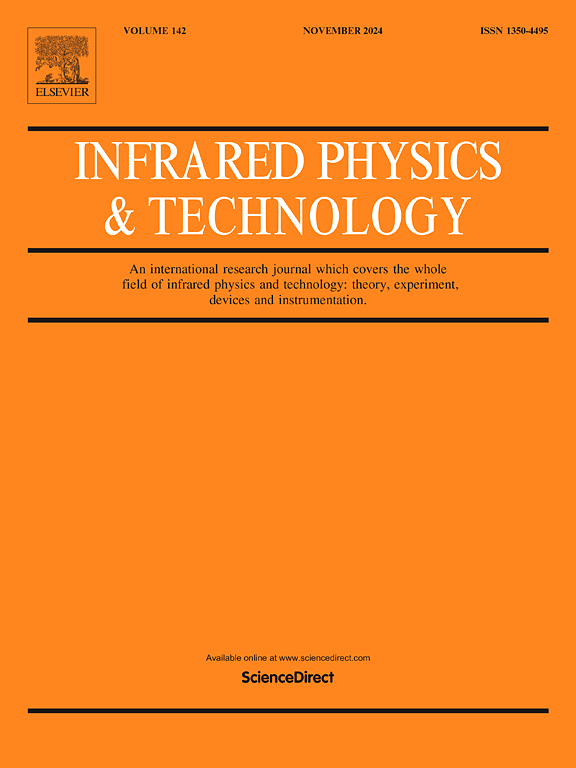Weyl半金属NbP纳米片的高性能太赫兹探测
IF 3.1
3区 物理与天体物理
Q2 INSTRUMENTS & INSTRUMENTATION
引用次数: 0
摘要
Weyl半金属(WSMs)以其独特的电子结构和拓扑性质,在传输和光电子应用中引起了极大的兴趣。其中,i型Weyl半金属NbP具有较高的载流子迁移率和较强的非线性光学响应,是红外和太赫兹(THz)探测的理想候选者。然而,传统薄膜制造的挑战限制了重金属过渡金属wsm在功能器件中的实际集成。在这项工作中,我们提出了一种基于化学气相输运(CVT)的高质量NbP纳米片合成策略,并成功地将其与领结天线结构集成在一起,开发了一种新型太赫兹探测器。该探测器工作在零偏置模式下,利用光子- weyl费米子相互作用实现高性能太赫兹探测。其检测范围为0.02 ~ 0.30 THz,响应时间为790 ns,噪声等效功率低至6.25 × 10-11 W Hz−1/2,响应率为156 V/W。此外,我们在本振带宽超过67 GHz的微波波段实现了外差混频。这些发现推动了wsm在光电探测中的应用,并为拓扑性质和光响应机制之间的相互作用提供了新的见解,为下一代太赫兹光子器件铺平了道路。本文章由计算机程序翻译,如有差异,请以英文原文为准。
High-performance terahertz detection in Weyl semimetal NbP nanosheets
Weyl semimetals (WSMs), with their unique electronic structures and topological properties, have garnered significant interest for transport and optoelectronic applications. Among them, Type-I Weyl semimetal NbP exhibits high carrier mobility and strong nonlinear optical responses, making it a promising candidate for infrared and terahertz (THz) detection. However, challenges in conventional thin-film fabrication have limited the practical integration of heavy transition metal WSMs into functional devices. In this work, we present a chemical vapor transport (CVT)-based synthesis strategy for high-quality NbP nanosheets and successfully integrate them with a bowtie antenna structure to develop a novel THz detector. The detector operates in a zero-bias mode, leveraging photon-Weyl fermion interactions to achieve high-performance THz detection. It demonstrates a broad detection range from 0.02 to 0.30 THz, an ultrafast response time of 790 ns, a noise equivalent power as low as 6.25 × 10-11 W Hz−1/2, and a responsivity of 156 V/W. Furthermore, we achieve heterodyne mixing in the microwave regime with a local oscillator bandwidth exceeding 67 GHz. These findings advance the application of WSMs in optoelectronic detection and provide new insights into the interplay between topological properties and photoresponse mechanisms, paving the way for next-generation THz photonic devices.
求助全文
通过发布文献求助,成功后即可免费获取论文全文。
去求助
来源期刊
CiteScore
5.70
自引率
12.10%
发文量
400
审稿时长
67 days
期刊介绍:
The Journal covers the entire field of infrared physics and technology: theory, experiment, application, devices and instrumentation. Infrared'' is defined as covering the near, mid and far infrared (terahertz) regions from 0.75um (750nm) to 1mm (300GHz.) Submissions in the 300GHz to 100GHz region may be accepted at the editors discretion if their content is relevant to shorter wavelengths. Submissions must be primarily concerned with and directly relevant to this spectral region.
Its core topics can be summarized as the generation, propagation and detection, of infrared radiation; the associated optics, materials and devices; and its use in all fields of science, industry, engineering and medicine.
Infrared techniques occur in many different fields, notably spectroscopy and interferometry; material characterization and processing; atmospheric physics, astronomy and space research. Scientific aspects include lasers, quantum optics, quantum electronics, image processing and semiconductor physics. Some important applications are medical diagnostics and treatment, industrial inspection and environmental monitoring.

 求助内容:
求助内容: 应助结果提醒方式:
应助结果提醒方式:


